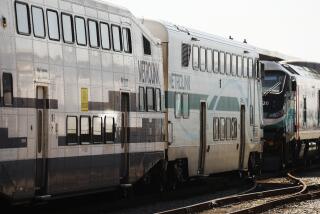Metrolink balked at safety upgrade’s cost
The head of Metrolink warned Congress a year ago that proposals to require updated safety devices on trains would involve “substantial cost” and urged lawmakers to give railroads “flexibility” in choosing and implementing the new systems.
The testimony came as part of a long-running argument over whether the federal government should require railroads to install safety devices known as positive train controls that can automatically apply the brakes if an engineer misses a stop signal.
Twenty-five people died and 135 were injured in a crash Friday in which a Metrolink commuter train collided with a Union Pacific freight train on a stretch of shared track in Chatsworth. Investigators say the Metrolink engineer went through a signal light that should have warned him to stop until the freight had moved onto a siding.
In the wake of the deadly head-on collision, political momentum to make the automated safety systems mandatory began to mount Tuesday, with local lawmakers and California Sens. Dianne Feinstein and Barbara Boxer calling for quick action.
“This accident happened because of a resistance in the railroad community in America to utilize existing technology to produce a fail-safe control of trains,” Feinstein said on the Senate floor. “The railroads have resisted, saying these systems are too expensive. Well, how expensive is the loss of human life?”
The Bush administration, in a statement a year ago, strongly opposed mandatory positive train controls, saying the technology “has not yet been proven.” Some experts disagree, however.
Feinstein introduced legislation Tuesday, co-sponsored by fellow Democrat Boxer, that would force railroad companies to install the systems by 2012 in high-risk areas where freight and passenger service mix and in all other areas by 2014, Feinstein spokesman Scott Gerber said.
Feinstein and Boxer hope to pass the measure before Congress recesses at the end of next week. The system would marry a global positioning system with digital communications that would track the location and speed of trains, automatically halting them if signals were ignored. The Federal Railroad Administration estimates that nearly a nationwide system would cost more than $2.3 billion, but some safety experts believe that figure is too high.
Philip J. LaVelle, a spokesman for Feinstein, said the Boxer-Feinstein bill is stronger than pending House and Senate bills that address positive train control technology because it would mandate the installation of systems in freight and passenger trains and impose stiffer penalties, including $100,000 fines, for companies that fail to comply.
The current House bill would require that only freight trains operating on high-risk corridors be equipped with the system. The Senate bill would mandate further studies but not the installation of positive train control.
In response to the earlier bills, the rail industry had raised questions of costs and proposed that companies develop systems on their own timeline. David Solow, Metrolink’s chief executive officer, urged a Senate subcommittee in July 2007 to provide “as much flexibility in the type of [train control] systems used and their implementation,” saying his agency remained “very concerned about the interoperability” for rail systems such as those in Los Angeles, where freight and commuter lines share tracks.
Solow, through a spokesman, declined to comment Tuesday.
On Monday, the head of the House Committee on Transportation and Infrastructure said the Metrolink accident was preventable, and he accused the rail industry of stalling the House bill.
“Our legislation requiring [positive train control] would substantially reduce the number of serious train accidents because it provides safety redundancy to protect against human performance failures,” said Rep. James L. Oberstar (D-Minn.). “However, the unwillingness of rail companies to make the needed investments in safety have prevented this technology from being fully implemented.”
Feinstein said Tuesday that positive train control is in place in the Chicago-Detroit corridor and in the Northeast corridor, but not in Southern California, which she said has the most high-risk track in the nation.
“We know that positive or safe train control would prevent 40 to 60 accidents a year, and seven fatalities and 55 injuries a year,” Feinstein said. “So, why hasn’t it been put in place? I actually believe it’s negligence, and I’ll even go as far to say that I believe it’s criminal negligence not to do so.”
Mechanical and electrical devices designed to stop trains if their crews did not heed signals date back to the 1920s. In 1937, Congress required automatic train stop systems to be installed on certain passenger corridors after a rash of deadly crashes. But the technology fell out of use as passenger rail service declined across the country.
A modern version of automatic train stop now operates on the Coaster commuter train line from Oceanside to San Diego. The freight trains that operate on the line do not have this system, however.
Tom Kelleher, a spokesman for the North County Transit District, which operates the Coaster, said that if a train does not react to a stop signal, an alarm sounds in the cab of the locomotive. The brakes set automatically if the engineer does not respond.
Officials investigating the Chatsworth crash said Tuesday that they had ruled out mechanical, track and train problems. The three signals that should have warned the Metrolink engineer to stop before hitting the freight train appear to have been working and visible prior to Friday’s catastrophic collision.
“We can say with confidence that the signal system was working,” National Transportation Safety Board member Kitty Higgins said as she summed up the early stages of what promises to be a lengthy examination.
One light was flashing yellow, which meant the engineer was supposed to slow down. The other light was solid yellow, a warning that there was a red light after the Chatsworth station, Higgins said.
“That indicates that you stop,” she said.
The engineer never hit the brakes, she added. Metrolink’s chief spokeswoman, Denise Tyrrell, resigned Monday after she was intensely criticized by superiors who said she had spoken prematurely in attributing the crash to the Metrolink engineer’s mistake.
In an interview Tuesday, the Metrolink conductor told investigators he did not talk to the engineer during the last two signals, an apparent breach of protocol. Safety board investigators conducted a reenactment of the accident and a “sight distance survey” on Tuesday to determine at what point the two train engineers might have seen each other.
In the test, two trains drove up to each other on the repaired track, then slowly reversed course until the two test engineers could no longer see each other. Investigators then measured the distance between the two engines.
That test showed that the engineer on the Union Pacific freight had only four seconds to react after he saw the oncoming Metrolink train. The engineer hit the brakes two seconds before the “point of collision,” Higgins said.
“By then,” she added, “it was too late.”
--
dan.weikel@latimes.com
Times staff writers Gale Holland and Steve Hymon contributed to this report.
More to Read
Sign up for Essential California
The most important California stories and recommendations in your inbox every morning.
You may occasionally receive promotional content from the Los Angeles Times.












